|
Introduction
You're proficient in C++, Java or another OO language, you're
designing class hierarchies, using inheritance, and manipulating
complex pointer relationships to store the necessary links between
your classes. You've probably drawn blobs (representing classes
in some way) on whiteboards, with connecting lines to indicate
the relationships between classes (inheritance or other). Perhaps
you're feeling the need for a more formal notation to express
your designs - using something that is language independent, and
that enables you to consider the important aspects of design leaving
the detail for later.
Alternatively, perhaps you're a
Project Manager, looking to formalise the OO design process a
little to make sure you're getting the most from your move to
C++/Java or a similar language.
In this paper, I take a look at
the UML (Unified Modelling Language) notation for Object Oriented
Analysis and Design - the emerging standard designed by Booch,
Rumbaugh and Jacobson, each of whom previously had their own notations
published independently.
The starting point is Object Modelling, a technique
that enables you to focus on class structure, inheritance, etc.,
whilst avoiding language specifics such as pointer dereferencing.
Object Modelling
In UML
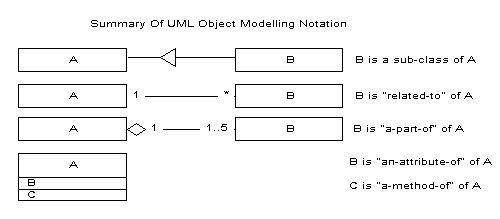
Figure 1 - Subset
of UML Object Modelling Notation - A Summary
Object Modelling is the central
technique in UML. It is a language independent notation allowing
the specification of classes, their data or attributes(private)
and methods (public), inheritance, and other more general relationships
between classes. The notation itself is fairly simple to grasp
(see figure 1), however this hides the somewhat more subtle thought
processes underlying a good model.
The best way to understand the notation
is to look at an example. The following Object Model shows a simple
Banking System, containing classes for Head-Office, Branch, Accounts
held at that Branch, and the Customers who the Accounts belong
to:
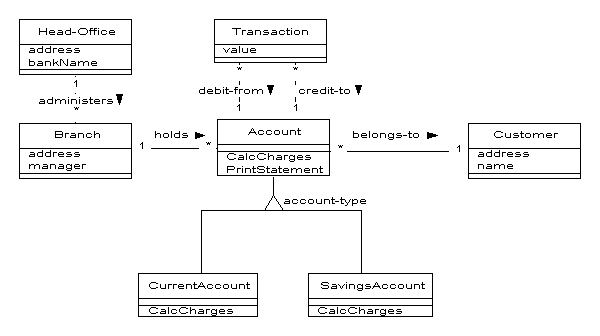
Figure
2 - A Simple Banking System Object Model
Examining this Object Model in more detail, we
can see the following information about our class structure:
- A Head-Office class (containing "bankName"
and "address" fields, otherwise known as attributes)
"administers" an (unspecified) number of Branch classes;
whilst a Branch is "administered-by" exactly one Head-Office
(the little black arrows indicates the direction in which the
name given to a relationship should be read). On the diagram
this relationship is represented by the line from the Head-Office
class to the Brach class which is labelled "administers".
The "1" at the Head-Office end of the line shows that
exactly one Head-Office is associated with each Branch (as you
would expect). The "*" at the Branch end of the line
shows that a Head-Office "administers" many Branches
- again as you would expect.
- Similarly, a Branch class (which contains
"manager" and "address" attributes) "holds"
many Account classes; whilst each Account class "is-held-by"
exactly one Branch. We can also see that we have determined
that an Account class has a "CalcCharges" method (also
known as operations or member functions) defined. This method,
when invoked, will look at the detail stored within the Account
object, and apply the appropriate (undoubtedly extortionate)
charges to the Account. The second method -"PrintStatement"
- will take the details of the Account and print them out.
- The inheritance "triangle" (labelled
"account-type") shows us that our system knows about
three types of Account: the basic account (in this case a virtual
class called Account), and two specialised accounts - the CurrentAccount
and SavingsAccount - which are derived from Account. The fact
that the "CalcCharges" is shown in both sub-classes
indicates that its implementation is re-defined for these classes
(in C++ terms it is a virtual function). This is indicative
of the fact that charges on a "SavingsAccount" are
calculated in a completely different manner to charges on a
"CurrentAccount".
- Implicit in the decision to use inheritance
and redefine methods in sub-classes is the fact that the system,
when implemented, will use the polymorphism features of the
target language (C++, Java ...) to enable all Accounts to be
treated in a single coherent fashion, regardless of the particular
charges mechanism involved. This is of course one of the reasons
we use an object-oriented development language in the first
place.
- Each Account "belongs-to" exactly
one owner - the Customer class on the diagram. Customers, on
the other hand, may have many Accounts.
It's worth noting here that because an Account
may "belong-to" a Customer, both CurrentAccounts and
SavingsAccounts may also belong to a Customer. In
other words, the "belongs-to" relationship between Accounts
and Customers is inherited by the CurrentAccount and SavingsAccount
classes. This fact simplifies the diagram considerably, removing
the need for these relationships to be noted explicitly. This
simplification will also be apparent in our final implementation
of the system.
- Finally, you can see that there are two
relationships shown between the Account and the Transaction
classes. This is because, in our banking system, each individual
transaction (credit, debit, etc.) must have two associated accounts
- the Account the money is "debit(ed)-from", and the
Account the money is "credit(ed)-to". This enables
the bank to record exactly where each transaction has come from,
and gone to, so to speak.
These last point brings out an interesting feature
of what is being shown on an Object Model: clearly it wouldn't
make sense for each Transaction to be "debit(ed)-from"
and "credit(ed)-to" the same Account - no money would
be transferred! Obviously, although the lines (relationships)
are shown to the same Account class, they do not (necessarily)
represent links to the same Account object at run-time.
A relationship shown on an Object Model indicates
that some kind of run-time link will exist between two instances
of the classes shown on the Object Model. Thus the Branch to Accounts
relationship should be read as follows:
An instance of the class Branch will be linked
to (zero to) many instances of the class Account, whilst an instance
of the class Account will be linked to (one and only) one instance
of the class Branch.
This can be shown more clearly by
the following instance diagram (instance diagrams are used to
assist in understanding and clarifying Object Models - they also
give quite a hint as to how relationships can be implemented in
C++!):
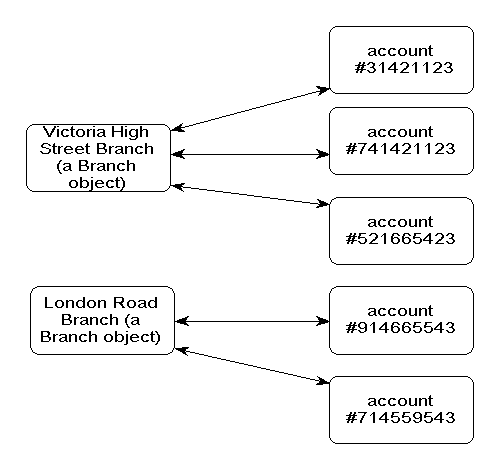
Figure
3 - Instance Diagram Showing Branch and Account objects
By now, you may be beginning to see how Object
Models can assist the analysis/design process. They assist in
the clarification of the relationships that should be (somehow)
represented in a software system. The important point to note
hear is that we are first working out what relationships we need
to represent in our system ("belongs-to", etc.), without
worrying too much about exactly how they should be stored. Put
another way, Object Modelling allows us to focus on exactly what
problem we are trying to solve, before we look at the best way
of implementing our model in a particular programming language.
Implementing
Object Models
OK, that's fine, you may say, but how do Object Models relate
to C++ or Java, exactly? Lets take a look at a sub-set of our
previous example:
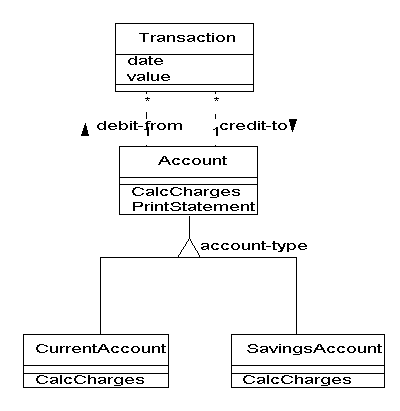
Figure
4 - Subset of Banking Model
Our Object Model shows us that we need four classes:
Transaction; Account; Current Account and Savings Account, and
that our implementation must enable us to represent the fact that
any particular Account has two sets of Transactions associated
with it - which will be needed to implement the PrintStatement
method. The Account, CurrentAccount and SavingsAccount classes
are easily mapped to the C++ (or Java) inheritance mechanisms:
class Account {
/* ... data ... */
public:
virtual void CalcCharges();
void PrintStatement();
};
class SavingsAccount : public Account {
/* any additional data
*/
public:
virtual void CalcCharges();
/* re-definition */
/* use the base class
PrintStatement method */
};
class SavingsAccount : public Account {
/* any additional data
*/
public:
virtual void CalcCharges();
/* another re-definition */
/* use the base class
PrintStatement method */
};
Figure
5 - Mapping Object Model Inheritance To C++ Inheritance
The Transaction class may be implemented as follows:
class Transaction {
long value;
/* stored in pence */
date_t date; /*
date of transaction */
public:
/* Access and Update
functions */
Date(date_t); /*
set */
date_t Date();
/* get*/
Value(long);
/* set */
long Value(); /*
get */
};
Figure
6 - Transaction Class In C++
This leaves us with the "debit-from"
and "credit-to" relationships to be implemented. Here
we have a number of choices: linked-lists; collection-classes;
(dynamically bounded) arrays of pointers; etc. could all be used
to represent these relationships.
class TransactionList {
TransactionList * next;
/* ptr to next element */
Transaction * data;
/* store the transaction here */
public:
void Data (Transaction
*); /* set */
Transaction * Data();
/* get */
void NextItem(TransactionList
*); /* set next ptr */
TransactionList * NextItem();
/* get next ptr */
};
Figure
7 - Simple Transaction List Handler Class
For brevity, a linked-list class
with a somewhat limited interface is used in this example - although
this may not the best choice.
Amending our Account class definition to use this class gives
us the following new definition:
class Account {
TransactionList * debitedFrom;
/* debited from Tx list*/
TransactionList * creditedTo;
/* credited to Tx list */
public:
virtual void CalcCharges();
void PrintStatement();
/* some new methods to manipulate the Transaction list */
DebitTx (Transaction *); /* Add a debit
Tx */
CreditTx (Transaction *); /* Add a credit Tx */
Transaction* NextDebitTx();
/* Iterator:get debit Tx */
Transaction* NextCreditTx(); /* Iterator:get cred Tx
*/
};
/* sample method implementation
*/
Account::DebitTx(Transaction * theTx) {
/*
add a new list contained at the beginning of the list */
TransactionList * tmpTxLp = debitedFrom;
debitedFrom = new TransactionList;
debitedFrom->NextItem(tmpTxLp);
/* new put the transaction
data into the list */
debitedFrom->Data(theTx);
};
Figure
8 - Account Class amended to use Transaction List
Although this is a somewhat simplistic
implementation - it demonstrates the point that the model shown
in figure 4 is easily translated into C++. Of course, better implementations
of the "debit-from" relationship are possible, but the
fact that the Account class interface completely hides the underlying
implementation of this relationship means that we can improve
on our first cut implementation at a later date with little impact
on our overall system code. In other words, use of the Account
class interface has limited the impact of the relationship implementation
method: something we strive to achieve when writing OO based applications.
A couple of other points are worthy
of note at this stage:
-
The linked list class contains
pointers (references in Java) to Transaction objects. This
is implicit in our Object Model, and is what the system's
users would expect to see. To see why, consider the case when
a new Transaction value is entered in error. The Transaction
is linked to two accounts ("debit-from" and "credit-to").
If the Transaction object is shared, only one object need
be modified to rectify the situation. Using two objects would
either mean that either the system has to update two objects
(equals more coding work), or that the user has to update
two Transactions (equals greater potential for mistakes).
-
Although our Object Model "debit-from"
relationship uses a linked list, there are many alternatives
to this choice - including the use of a relational database
to underpin the system. The point is, however, no matter what
mechanism is used, we are actually trying to implement a "many-to-one"
relationship between an Account and a Transaction. It is this
relationship that exists in the banking problem domain - not
a relationship involving linked lists or collection classes.
Object Modelling enables us to spot the relationship required
by the problem domain, and then choose the best way of implementing
it.
-
So far, we have only implemented
the "debit-from" relationship in one direction-
from the Account class to the Transaction class. Our model
does not (yet) specify in which direction the relationship
will be traversed. If we need to traverse the relationship
in both directions - getting from the Transaction to the related
Account - our implementation will prove insufficient, and
some form of double pointer schema may be needed. Much work
would have been saved if we had known this fact before we
had started writing the code.
-
Other factors may also influence
our choice of implementation: do we need a direct form of
access - for example using a Transaction number to go directly
from the Account to the relevant Transaction? If we do, then
a linked-list will prove an inefficient choice of implementation.
Again, it would be very useful to know this type of information
before we start trying to implement the relationship.
From these points we can see that
we need to consider the wider requirements of our system before
we can come up with the right implementation of our "debit-from"
relationship (not to mention the many other classes and relationships
that might be required). We can't produce a good design for a
system unless we consider all the required functionality - in
detail. Use Cases provide the mechanism for doing this.
Use
Cases In UML
Use Cases are used to document system requirements. They provide
a useful technique which, in conjunction with Object Modelling,
help us to clarify exactly what the system is supposed to do.
Let's take a look at the requirements for our banking system:
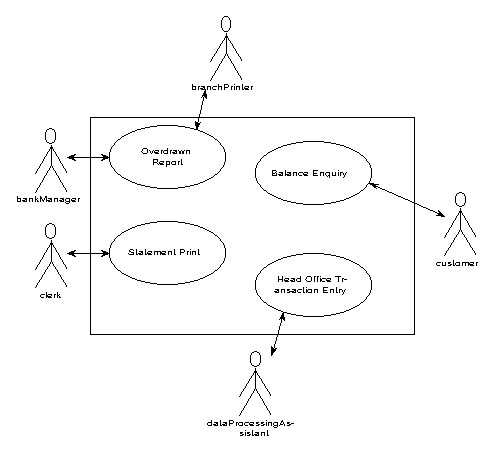
Figure
9 - Use Cases for Banking System
This Use Case diagram shows us the
following:
-
The required business functions
- that is, the type of operation you'd expect to find on the
menu of the application once it had been developed. In this
case we have identified the following functions:
-
Bank managers need to periodically
print out a report detailing all the customers who are overdrawn;
these appear on the branch printer
-
Customers may use the system
for balance enquiries
-
Data processing staff use the
system to do basic data entry (transactions on accounts)
-
Clerks may periodically request
statements on behalf of Customers;
-
There are four distinct types
of user of the system: Bank Managers; Clerks; Data Processing
Assistants; and Customers. Each type of user typically has
their own particular set of requirements for a system: hence
identify user types assists in identifying all the required
system functions.
The Use Case diagramming technique
allows us to make a first cut at defining the system requirements,
and will help us in presenting these requirements back to the
users of the system. It also partitions the system into single
atomic business functions, which may be used as a basis for costing
the system, or for planning a phased system delivery. In this
case each successive phase would deliver further batches of Use
Cases.
Further information is still required, however, to tie down the
detail of what each businese function does. Use Case Detail provides
this information (explanatory notes are shown in bold):
| Use
Case Detail: Overdrawn Report
Used
By:
Bank Manager
Inputs:
Details what information flows from the user to the
system for this particular Use Case.
theBranchSortCode - The Sort Code of the branch for which
the report is required.
theOverdraftPeriod - how long an Account has been overdrawn
before it is forms part of the report.
Outputs:
Details what information flows from the system to the
external environment, in this case the printer!
overdraftReport (to branchPrinter) - structured as follows:
customer name; current overdraft; period overdrawn (days);
Printed for all accounts that have been overdrawn for
a period greater than
theOverdraftPeriod, and which have not already been reported
(on another report) in the last 30 days.
Pre-Conditions:
What validity checks or constraints apply on the inputs
(or the internal system as a whole, in some cases).
theBranchSortCode - must be a branch sort code held within
the system.
theOverdraftPeriod - must be a number between 0 and 100
days.
Post-Condition:
What changes does the Use Case make to the internal
system state.
Updates the reportedOnDate field of overdrawn accounts.
|
As work progresses on the Use Cases,
the requirements of the system become clearer enabling the Object
Model to be updated in parallel, helping us make sure our model
(and the subsequent implementation in the chosen language) contains
all the necessary classes and class inter-links.
Whilst we're nearer to resolving some of the issues identified
at the end of the discussion of implementing Object Models, a
number are still outstanding: we still can't be sure in what direction
the relationships must be implemented, whether we have identified
all the methods; or what implementation of the links will best
suit the use to which they'll be put. To sort out the remaining
issues we'll need to look in more detail exactly how each Use
Case will be implemented, using Sequence Diagrams.
Sequence
Diagrams
Sequence diagrams, performed on a per Use Case basis, examine
the flow of method call calls within a system.
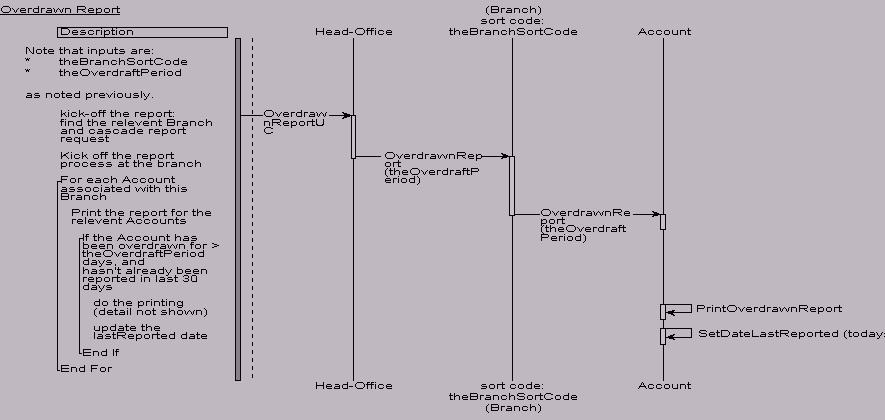 Figure
10 - Sequence Diagram for Overdrawn Report Figure
10 - Sequence Diagram for Overdrawn Report
Performing a complete analysis requires
that each individual Use Case must be examined, although in practise
only selected Use Cases may be examined. The Sequence Diagram
in figure 10 shows the Overdrawn Report Use Case defined earlier.
The Overdrawn Report Use Case is thus implemented as follows:
-
The Head-Office object (there
is only one of them) has methods which correspond to each
Use Case - in this case an OverdrawnReport method (this is
a convenience for brevity, normally there would be a single
"InitialObject" which the system would know about,
and which would provide the entry point into the run-time
model for all code).
-
The Head-Office OverdrawnReport
method locates the relevant Branch (as determined by the Use
Case input: theBranchUseCase) and cascades the request to
the Branch by calling its OverdrawnReport method.
-
The Branch object in turn passes
the request on down to each Account it holds (using the Account's
OverdrawnReport method)!
-
Each Account then:
-
checks if it has been overdrawn
for greater than the period specified by theOverdraftPeriod,
which is passed as an argument to the Account.OverdrawnReport
method (the detail of this is not shown - but involves summing
up all the Transactions it holds, and checking the date on
which it last became overdrawn).
-
if appropriate it then calls
one of its own methods to print the report (detail not shown),
and resets its lastReportDate attribute, again using its own
method.
-
The method calls unwind until
the Use Case is complete.
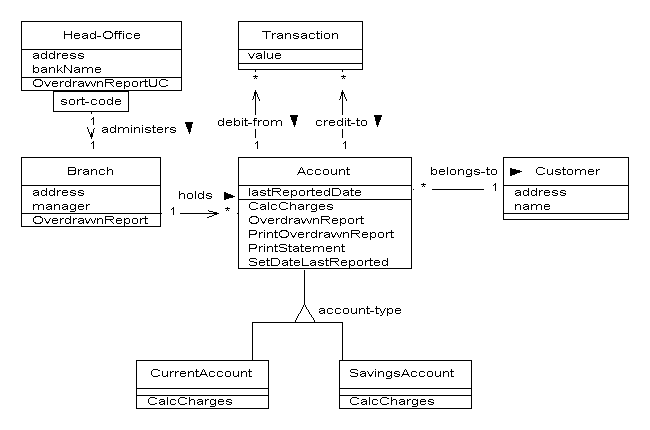
Figure
11 - Updated Banking System Object Model
Reviewing the Object Model (see
figure 11), we can see a number of additions as a result of
completing this Sequence Diagram:
-
OverdrawnReport methods have
been added to the Branch and Account classes.
-
A lastReportedDate attribute
and associated methods have been added to the Account class,
along with a printOverdrawnReport method.
-
The "administers"
relationship between Head-Office and Branch has been qualified
to indicate that "direct access" via the Branch's
"sort-code" is required across the link (thus assisting
in link design) - note the consequent change in the multiplicity
of the relationship from many-to-one to one-to-one.
-
We have added directionality
to many of the links (e.g. see the arrow-head on the Branch
to Account link).
Of course, we've only looked at
one Use Case, so its likely the model will change further as more
sequence diagrams are developed.
The
Overall Process
From the above discussion we can see that Use Cases and Sequence
Diagrams both add to integrity and completeness of our Object
Model, and that a good Object Model provides a firm foundation
for a good design, and hence a good implementation of the system.
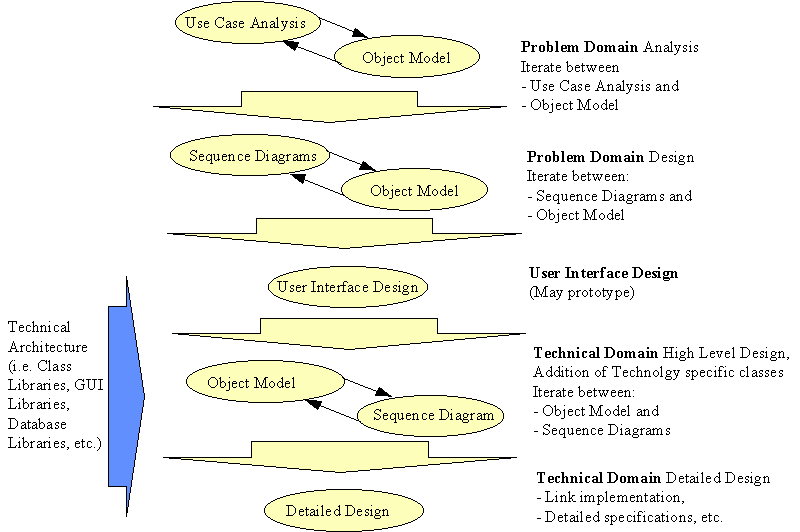
Figure
12 - The Overall Process
This approach separates the Problem
and Technical Domain aspects of the project:
-
Problem Domain Design is concerned
with finalising the detail of the problem domain parts of
the Object Model, and results in an Object Model with a complete
set of Problem Domain specific classes, attributes and methods.
-
User Interface Design is the
first step that focuses on the Technical Domain aspects of
the problem, and involves taking the Use Cases as defined
earlier, and designing a Graphical User Interface appropriate
to the Technical Architecture chosen for the project (MS Windows,
X/Motif, etc.). Typically you would expect to find one controlling
dialog box (which may use other subsidiary dialogs) for each
Use Case in the system. Some prototyping may be appropriate
at this point in the project. For small projects, prototyping
and UI design may be undertaken in parallel with Use Case
development.
-
Technical Domain, High Level
Design focuses on adding classes to meet the technical needs
of the project, and is driven by the technical architecture
of the project. Classes may be GUI related, DBMS (object or
relational) related, distribution related (CORBA, DCOM, etc.),
external systems related, or may provide an interface to internal
system components such as printers. Previous Sequence Diagrams
may be updated to confirm the validity of the technical design
- in particular you would expect to see GUI classes appearing
between the System Boundary and the Problem Domain classes.
-
Finally, Detailed Technical
Design, looks at link implementations, detailed data typing
of attributes, full specification of all methods (including
parameters), etc. The end result is a complete design of the
full system.
The separation between Problem Domain
and the Technical Domain aspects of the system is useful in large
projects, allowing the focus of those working on the project to
be clearly divided, as summarised in figure 13:
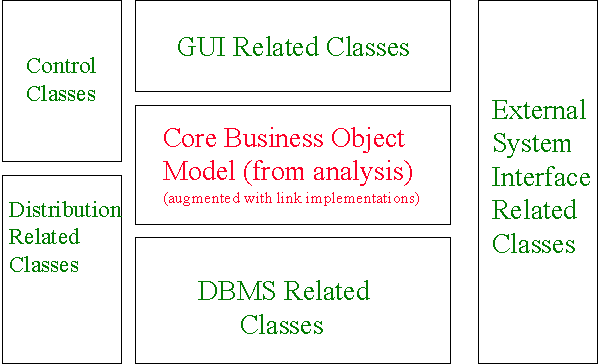
Figure
13 - Seperation Of Problem and Technical Domain Components
of a System
For smaller projects (one or two
persons for a couple of months) the two domains may be merged,
if desired.
As mentioned previously, Use Cases may be used in phasing a project;
the process shown earlier does not prohibit this. A project with
50 Use Cases could be structured in three phases as shown in figure
14:
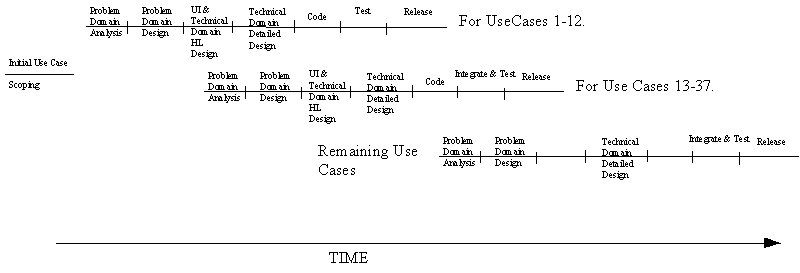
Figure
14 - Evolutionary Phasing Of OO Project
The object-based structure of the
application lends itself well to this approach.
Summary
This paper has taken a look at the Use Case, Object Modelling,
and Sequence Diagramming notations of UML, how Object Modelling
maps to OO programming languages, and shown how these notations
hang together to complement each other. A number of other UML
notations are not covered in this article, however further information
can be found on www.ratio.co.uk.
I hope you can see that OOA/D offers
a number of potential benefits in an OO based development environment.
These include:
-
better modelling of the problem
domain (equals happier users)
-
better overall software design
with a strong focus on class structure
-
more flexible and maintainable
systems through better class partitioning
-
good documentation (the notations)
- and a single central overall design notation (the Object
Model)
-
a flexible approach to project
phasing
-
assistance in tie-ing down requirements,
and
-
less work (in the long run)
Mark Collins-Cope is Technical
Director at Ratio Group Ltd., a consultancy and training company
specialising in OO related methods, languages and technologies.
For further information on OOA/D using UML, Java, C++, Design
Patterns or related topics please call 0171 386 9600 or email
info@ratio.co.uk.
Copyright
This material remains the copyright of Ratio Group Ltd. Licence
is granted for the use of this material for personal development
purposes only. |

